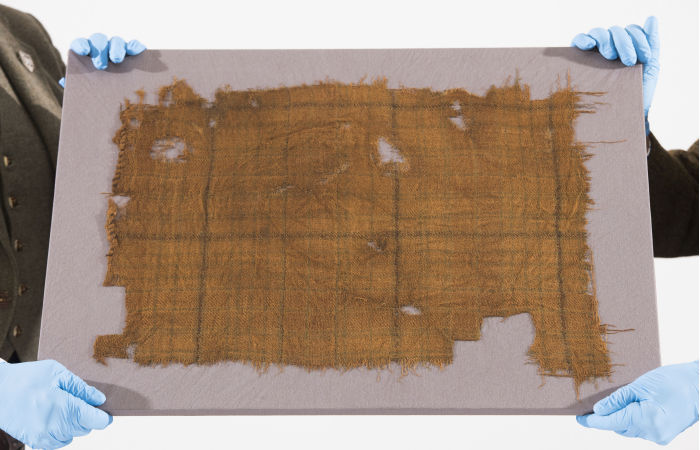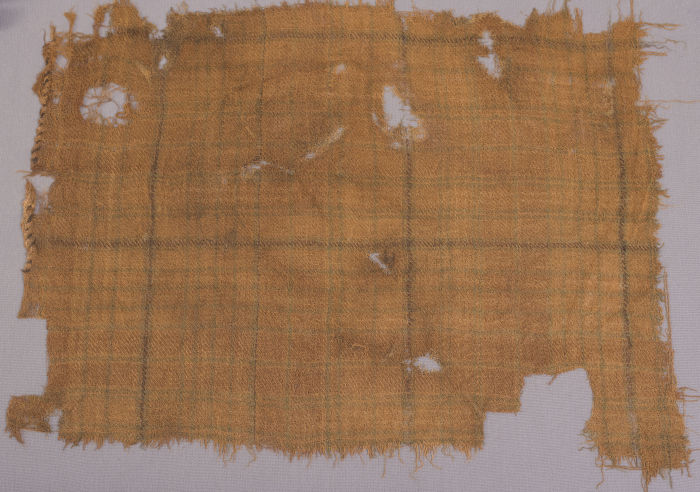Jan Bartek – AncientPages.com – New scientific research has revealed a piece of tartan found in a peat bog in Glen Affric around forty years ago can be dated to circa 1500-1600 AD, making it the oldest known surviving specimen of true tartan in Scotland.
The Scottish Tartans Authority commissioned Dye Analysis and Radiocarbon testing on the woolen textile to prove its age.

Glen Affric tartan – Scotland’s oldest-known true tartan discovered by The Scottish Tartans Authority to go on display for the first time at V&A Dundee’s Tartan exhibition. Credit: Alan Richardson Pix-AR
The first investigation was dye analysis carried out by analytical scientists from National Museums Scotland. Using high-resolution digital microscopy, four colors were visually identified for dye analysis: green, brown, and possibly red and yellow.
The dye analysis confirmed the use of indigo/woad in the green but was inconclusive for the other colors, probably due to the dyestuff degradation state. However, no artificial or semi-synthetic dyestuffs were involved in making the tartan, which pointed to a date of pre-1750s.
Further clarification on the age of the tartan involved radiocarbon testing at the SUERC Radiocarbon Laboratory in East Kilbride. The process involved washing out all the peat staining, which would have otherwise contaminated the carbon content of the textile.
The Radiocarbon testing results identified a broad date range between 1500 and 1655 AD, with the period between 1500 and 1600 AD the most probable. This makes it the oldest-known piece of true tartan found in Scotland – the Falkirk ‘tartan,’ dating from the early third century AD, is actually a simpler check pattern woven using undyed yarns.
The Glen Affric tartan, which measures around 55cm by 43cm, is now on display for the first time at V&A Dundee’s Tartan exhibition.
The piece will be the oldest exhibit among more than 300 objects. The exhibition examines tartan’s universal and enduring appeal through iconic and everyday examples of fashion, architecture, graphic and product design, pH๏τography, furniture, glᴀss and ceramics, film, performance, and art.
“The testing process has taken nearly six months, but the effort was well worth it, and we are thrilled with the results!
In Scotland, surviving examples of old textiles are rare as the soil is not conducive to their survival. As the piece was buried in peat, meaning it had no exposure to air and was therefore preserved.
The tartan has several colors with multiple stripes of different sizes, and so it corresponds to what people would think of as a true tartan.
“Although we can theorize about the Glen Affric tartan, it’s important that we don’t construct history around it. Although Clan Chisholm controlled that area, we cannot attribute the tartan to them as we don’t know who owned it.
“The potential presence of red, a color that Gaels considered a status symbol, is interesting because of the more rustic nature of the cloth. This piece is not something you would ᴀssociate with a king or someone of high status; it is more likely to be an outdoor working garment,” Peter MacDonald, Head of Research and Collections at The Scottish Tartans Authorit said.

New scientific research has revealed a piece of tartan found in a peat bog in Glen Affric, Scotland around forty years ago can be dated to circa 1500-1600 AD, making it the oldest known surviving specimen of true tartan in Scotland. Credit: Credit: Alan Richardson Pix-AR
“The Glen Affric tartan is clearly a piece of national and historical significance. It is likely to date to the reign of James V, Mary Queen of Scots, or James VI/I. “There is no other known surviving piece of tartan from this period of this age. It’s a remarkable discovery and deserves national attention and preservation. “It also deserves to be seen and we’re delighted that it is to be included in the Tartan exhibition at V&A Dundee,” John McLeish, Chair of The Scottish Tartans Authority, said.
“We knew The Scottish Tartans Authority had a tremendous archive of material and we initially approached them to ask if they knew of any examples of ‘proto-tartans’ that could be loaned to the exhibition.
I’m delighted the exhibition has encouraged further exploration into this plaid portion and very thankful for The Scottish Tartans Authority’s backing and support in uncovering such a historic find.
To be able to exhibit the Glen Affric tartan is immensely important in understanding the textile traditions from which modern tartan derives, and I’m sure visitors will appreciate seeing this on public display for the very first time,” James Wylie, curator at V&A Dundee said.
Tartan at V&A Dundee opens on Saturday, 1 April, until 14 January 2024.
Written by Jan Bartek – AncientPages.com Staff Writer





